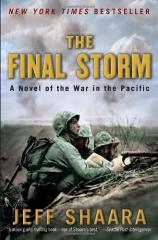The Final Storm: A Novel of the War in the Pacific
Review
The Final Storm: A Novel of the War in the Pacific
Spring, 1945. With the war in Europe beginning to stagger to a conclusion, attention is turned to the Pacific Theater. The empire of Japan had been overtaking segments of southeast Asia and islands throughout the Pacific since before World War II was officially launched, but the tide was starting to turn. U.S. forces under the command of folks such as Nimitz, Buckner and MacArthur were beginning to drive Japan back toward their homeland, and all that was needed for a proper assault was a secure island to use as a staging ground. The island the U.S. chose as the perfect ground was Okinawa.
THE FINAL STORM details the assault on Okinawa: an 82-day bloodbath that featured some of the fiercest and most brutal fighting of the war. Following a series of bombing missions and submarine attacks, Allied troops begin an earth-shaking bombardment of Okinawa from the sea prior to the largest amphibious landing seen in the Pacific. Soldiers storm the beaches, but unlike Normandy, where men fell in waves under the heated fire of German guns, there is no resistance from the Japanese. Inland they sweep, securing section after section, a minor skirmish here or there, but no outward aggression of note. Where is the enemy? Why do they not strike?
Tensions mount and the men are uneasy. When the counter-strike does begin, it is ferocious and horrific, with the civilian population of Okinawa caught in the midst of it. More disturbing is the realization that, like previous island populations, the people of Okinawa have taken to heart the Japanese propaganda about the savagery of the U.S. forces and are only too willing to kill themselves than be prisoners under U.S. occupation.
In the meantime, a secret project is meeting with success, and Harry Truman is prepared to order the devastating attack on Hiroshima and Nagasaki with a weapon that will forever change the face of war, and of the world at large. Colonel Paul Tibbets is charged with carrying the bomb known as Little Boy, and dropping it over Hiroshima, horrifying the world and crippling Japan, essentially bringing an end to World War II.
Jeff Shaara explains in an opening letter to the reader that THE FINAL STORM was a book that ultimately needed to be written. He had received letters from veterans who were disappointed that he was neglecting and ignoring their stories about what had happened on the Pacific side of the world after he had spent three books detailing the European Theater. As he usually does, Shaara delved deep into personal archives, diaries and interviews in order to craft a compelling and historical record that in many ways rivals standard history texts. The giants of history are presented here, on both sides of the war, and the action unfolds under their dutiful watch.
The most compelling, and the everyman for readers, is Clay Adams, a Marine who has missed most of the combat with illness, and is now being thrust into the thick of the fight as Okinawa is taken. Adams fights not only for his country but to show his family that he is just as worthy as his older brother, a man who has served with distinction in Europe as a member of the 82nd Airborne. In fact, if you've come along for Shaara's story from the beginning of the World War II trilogy, you will recognize Jesse Adams from the second book, THE STEEL WAVE. It's a great way to complete the circle, tie this stand-alone volume to the full body of the whole series, and it also serves to highlight the plight of families who had multiple sons serving.
The brutality of the Okinawa battle is laid open in very vivid terms. Readers feel the trepidation and the fear, and also get the insight of the Japanese mindset --- the belief that death is a better end than failure, and they get the chance to see the battle from the eyes of Mitsuru Ushijima, the Demon General. By the time the devastation is over, you'll feel like you've been through your own mini-war. With the dropping of the bomb on Hiroshima, the story rapidly begins to wrap up, and this may be the only downside to the story: the hurried end. A few more chapters to lay out the finality of the story may have better served the tale, yet the book still stands as a tremendous project of great merit. Also missing, and rightfully so, are any judgments about the decision to wreak such devastation on Japan with atomic weapons. Instead, it only shows the thoughts, ideas and actions of the moment, not of the generations of perspective that examined events have since had piled upon them. In refusing to move down this path, Shaara keeps the story rooted in its element and makes it a more genuine experience.
Jeff Shaara has an incredible résumé and a tremendous body of work left behind after years typing out these stories. It would be impossible to argue that he is not the preeminent historical fiction writer of our time. While his work cannot be technically classified as "history," readers can learn a lot more about our past from his books, and in a more enjoyable manner, than a majority of dry textbooks can offer. He has made history easily accessible for anyone with the inclination to crack open the spine on one of his books. With THE FINAL STORM, he very well may have put down his finest effort to date.
Reviewed by Stephen Hubbard on May 24, 2011
The Final Storm: A Novel of the War in the Pacific
- Publication Date: January 10, 2012
- Genres: Fiction, Historical Fiction
- Paperback: 480 pages
- Publisher: Ballantine Books
- ISBN-10: 0345497953
- ISBN-13: 9780345497956





